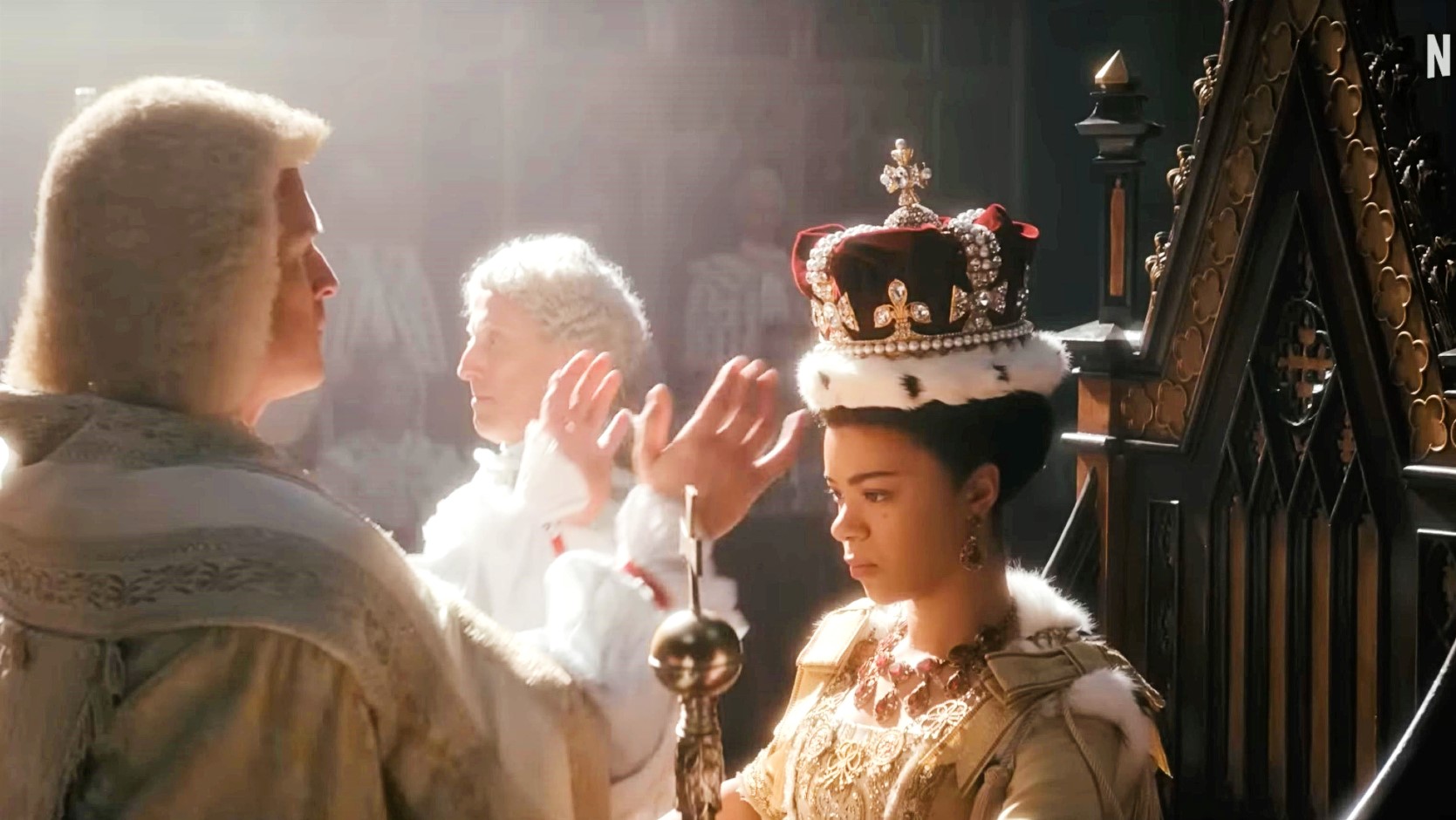There were two coronations the weekend of May 6th: One in England and one in Shondaland. For those who don’t know, England is a small country at the center of the British Isles. At one time its empire of colonized countries stretched from North America, across the Caribbean to India, Africa, Southeast Asia, and Australia. Now its primary export is classically trained British actors for period dramas like Shonda Rhimes’ Bridgerton series on Netflix.
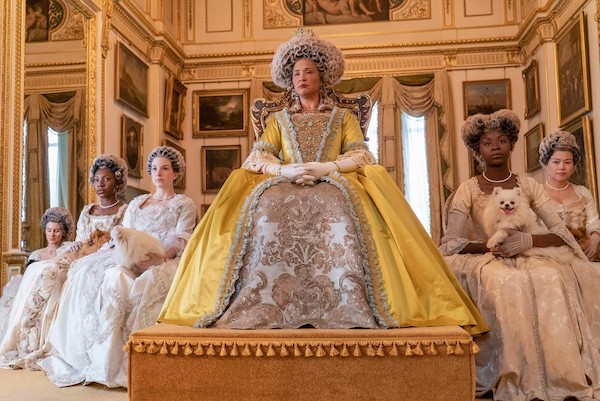
Bridgerton is the story of the rich, beautiful Bridgerton siblings and their search for love. Based on a series of garden variety romance novels by Julia Quinn, in the hands of television phenom Shonda Rhimes the books have become something spectacular. Like a fairy godmother, Rhimes gives them a technicolor transformation. The production design is breathtaking. Palatial English manors, actresses swathed in yards of brocade fabric and sparkling jewelry, horse drawn carriages, elaborate wigs, five fluffy Pomeranians!
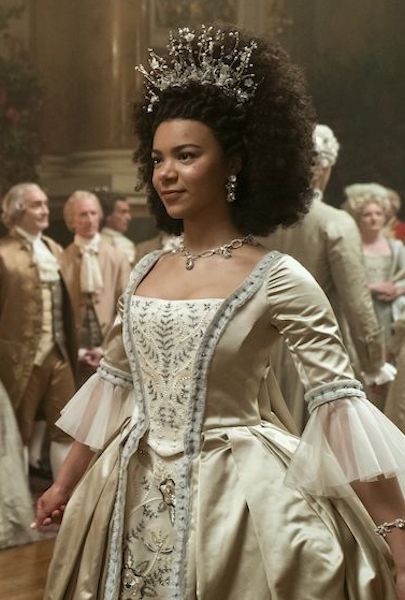
Rhimes also added color to the casting. In a departure from the books, many major characters, including the major love interests and the queen of England herself, are played by Black and Indian actors. The color conscious casting was a deliberate choice on the part of Rhimes who loves period novels, but never saw anyone who looked like her in them. The scripts reflect the social strain that diverse peers might have experienced in regency England.
The latest Bridgerton installment is the spinoff Queen Charlotte. A prequel to the rest of the regency Romances, Queen Charlotte is the story of the romance between King George III and Charlotte of Mecklenburg-Strelitz. The series opens with the disclaimer:
“This is the story of Queen Charlotte from Bridgerton. It is not a history lesson. It is fiction inspired by fact. All liberties taken by the author are quite intentional. Enjoy.”
If only the coronation of Charles III could have issued a similar disclaimer,
“This is the coronation of King Charles III. Forget everything you know about the history of England. The liberties taken by the royal family to indulge themselves are quite substantial. Enjoy.”
King Charles III’s coronation was even glitzier than the fictional one of Queen Charlotte and King George III. The crown worn by Charles was made for the coronation of his predecessor Charles II. After a decade of Puritanical rule, the Restoration of the Monarchy ushered in a period of excess, starting with the gold and jewel encrusted crown. The funding for this excess came in part from the monarchy’s investment in the slave trade. Previous monarchs had dabbled, but Charles II was the first to give slavers a royal charter. He and his brother, King James II, also both invested in the Royal African Company, which was responsible for transporting more enslaved Africans to the Americans than any other single organization.
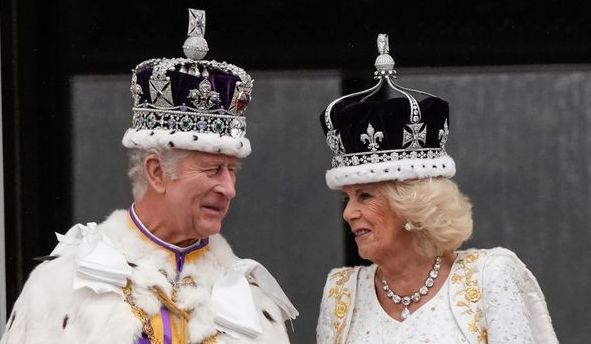
The monarchs that followed enlarged the palace purse with their own investments in the trafficking of enslaved Africans, until slavery was officially outlawed in England in 1807. Yet, for the monarchy, this was not a significant financial setback. Even with slavery banned, the economy continued to benefit from the exploitative labor producing cotton in America and sugar in the Caribbean. Furthermore, who cares about America when one can be Empress of India? The United Kingdom expanded its empire in the 19th century to encompass India, swaths of Africa and Asia, Australia, and parts of the Middle East. The sun never set on the British empire’s exploitation of colonized land and labor.
“The sun never set on the British empire’s exploitation of colonized land and labor.”
In recognition of the controversy around colonization, the sacred Koh-i-Noor diamond stolen from India by the British for Queen Victoria was removed from the crown of Queen Camilla and replaced by a less overt symbol of domination, the Cullinan Diamond from South Africa. However, The Cullinan Diamond was found in South Africa and given to the monarchy in 1907 to smooth over the aftermath of the Boer War. It still symbolizes white imperial power stealing the resources of native peoples to win political favor.
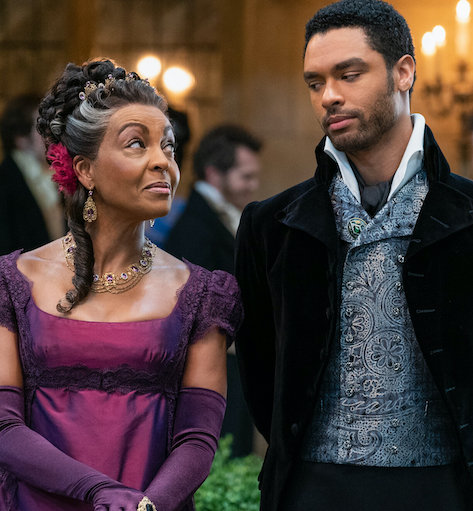
Capitalism is the driving force behind colonialism and requires the oppression of indigenous people. The method preferred by European monarchies is to dehumanize native people by classifying them as “other,” by religion, skin color, or both. England excels at this even today, which is why so many voted in favor of the Brexit referendum. It’s also why there’s so much animosity towards Meghan Markle in the royal family and amongst the white tabloid reading populace. While Netflix fans adore Bridgerton’s Queen Charlotte as portrayed by bi-racial actress Golda Rosheuvel, the actual bi-racial Duchess of Sussex declined to attend the coronation to avoid the racism that dogs her every step in Great Britain.
The plotlines and characters of the fictional Bridgerton series spend more time addressing racism and colonialism in their fictional England than the monarchy of the actual United Kingdom. A recent survey showed people of color in the UK are more likely to believe the royal family is racist, which is in line with negative views toward the monarchy by younger generations. Charles III expressed regret for the slave trade on a trip to Ghana in 2018 and has signaled support for research into the crown’s involvement with the slave trade, but more is required from a man whose 2 billion GBP fortune was built on the backs of enslaved people.
THE PLOTLINES AND CHARACTERS OF THE FICTIONAL BRIDGERTON SERIES SPEND MORE TIME ADDRESSING RACISM AND COLONIALISM IN THEIR FICTIONAL ENGLAND THAN THE MONARCHY OF THE ACTUAL UNITED KINGDOM.
The monarchy needs to throw its full-throated support behind reparations. If the UK could pay billions to compensate slave owners, the funds for which came from a loan only finally paid off in 2015, then the nation needs to do more for the descendants of slaves and their communities.
An army of forensic accountants should dig through the royal family’s financial past and scrutinize the sources of their vast wealth – especially considering the King, as the head of state, is not subject to many of the same tax laws that govern his subjects and owns some of the most profitable land in England. This vast wealth could be used to fund reparations to descendants of colonization and slavery.
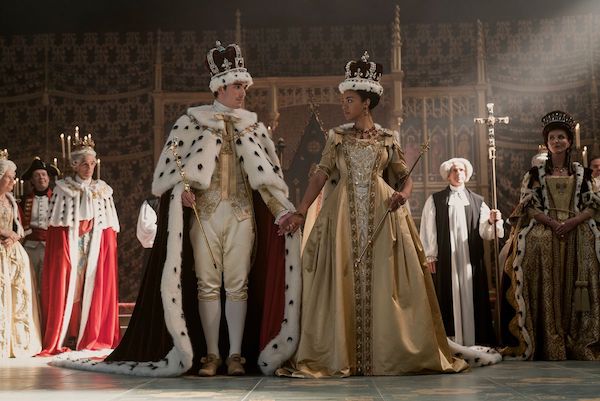
Such acts would go a long way towards creating a more just nation, and one the citizens of the United Kingdom could be proud of. The racial equity of Bridgerton doesn’t have to exist as a purely fictional ideal. Amongst the pomp and pageantry, Christ’s example of servanthood played a major role in the coronation of King Charles. If the King took this message to heart and, like Christ, divested himself of even some of his power and glory, then perhaps he would be a figurehead worth admiring. Until then, at least we have Bridgerton’s fictional king and queen.



















